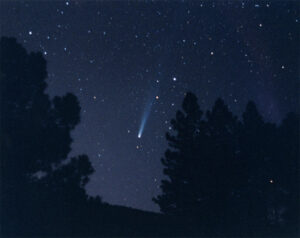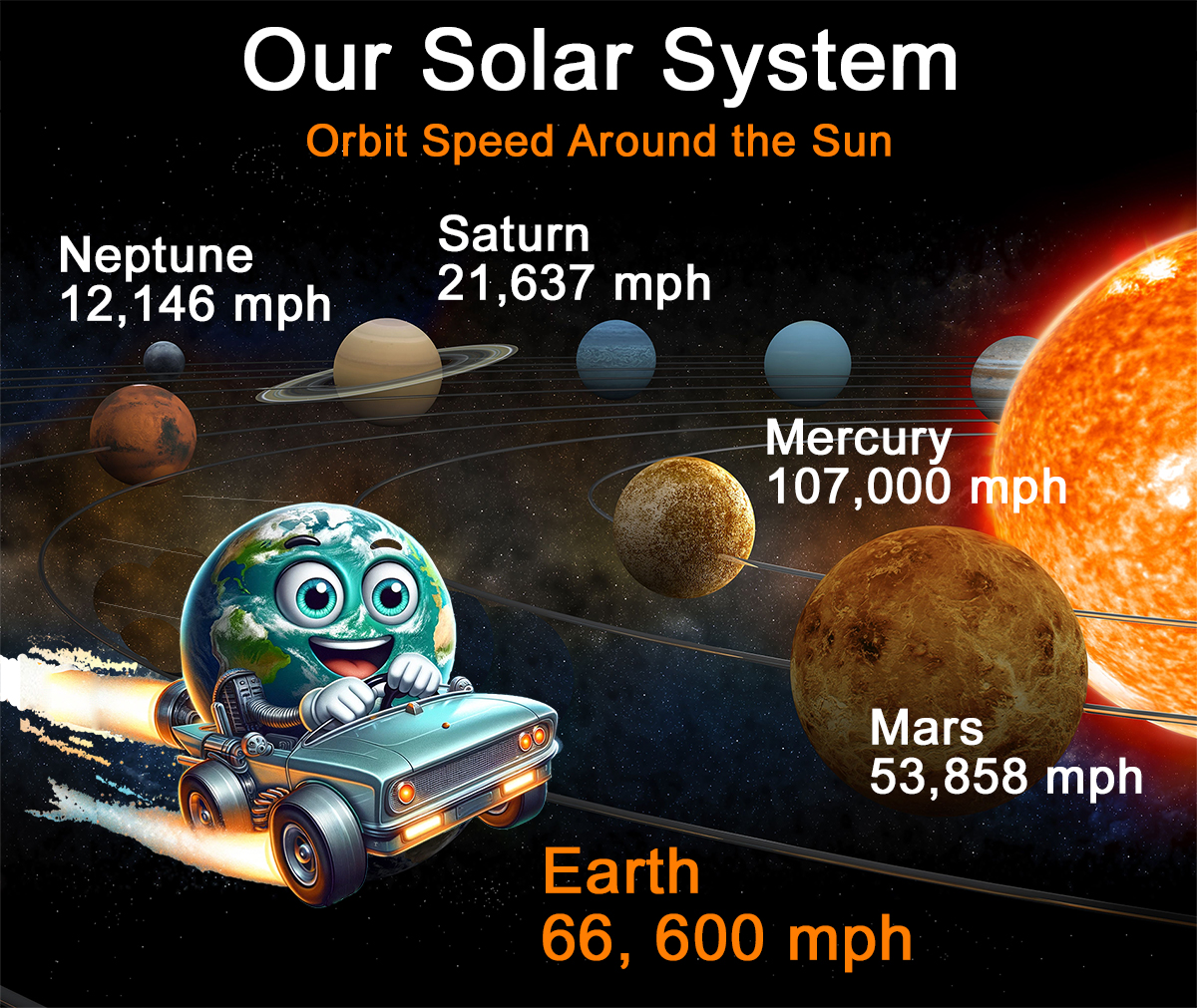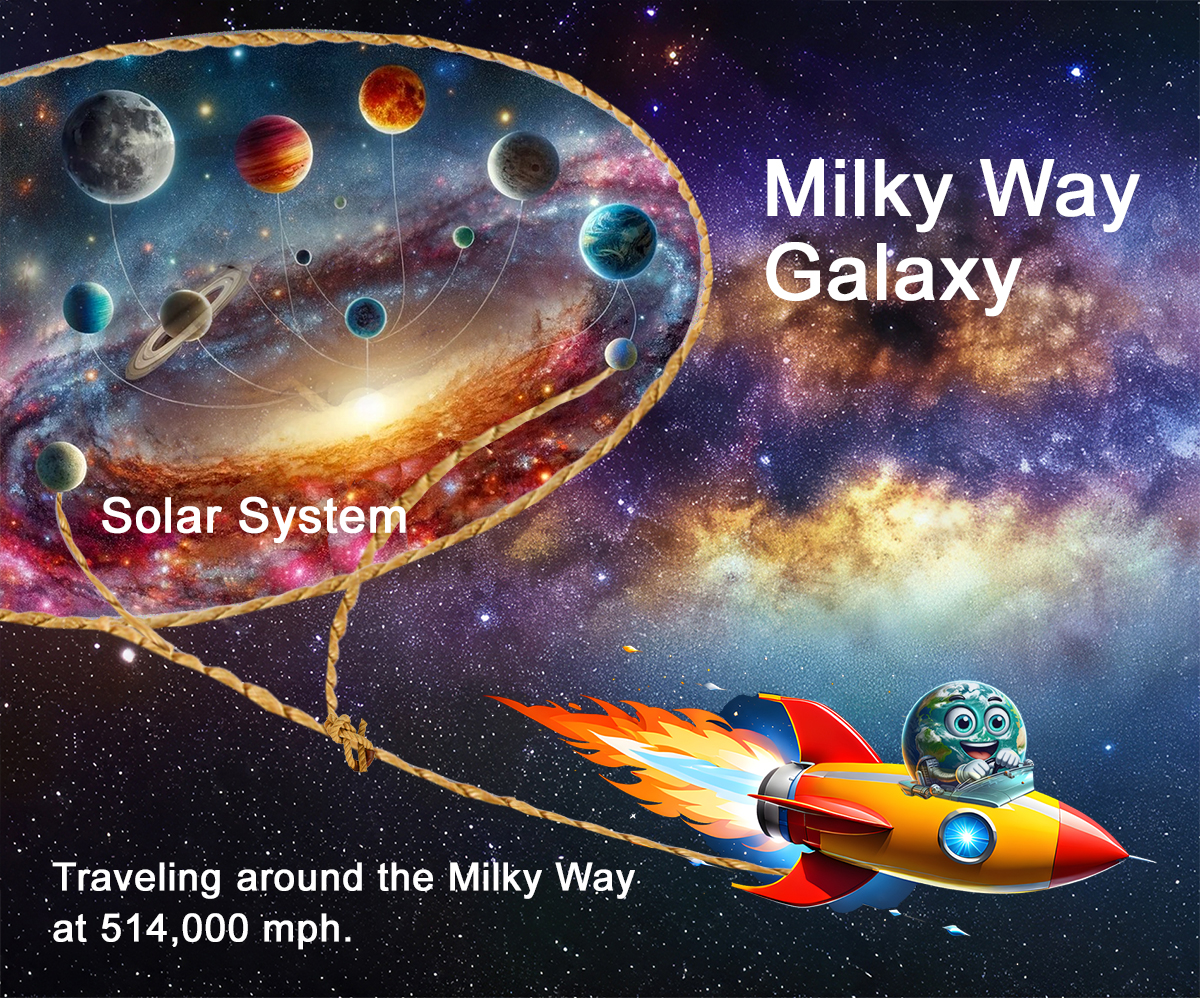

Hello,
Every now and then I find myself gazing up at the heavens. As always, I am awed by its magnitude, overwhelmed by its complexity, unable to truly grasp what I see or understand just what is going on out there. Most of the universe is of course beyond both our vision as well as human comprehension. Science has made great strides during our lifetime in traveling ever deeper into space. Combining more powerful telescopes that cannot only see further but observe certain wavelengths of light previously undetectable such as ultra-violet and near-infrared. Enabling them to see through dust clouds that once obscured their vision, thanks mostly to the Hubble Space Telescope (1990) and the James Webb Space Telescope (2021).
Mankind has gone from living on a flat earth at the center of the universe to a lonely planet in one solar system circling a singular galaxy that may be one of trillions. All part an ever-expanding universe dating back perhaps 13.8 billion years. From the Gods directing the stars to a secular Cosmos filled with quasars, black holes and dark matter.
Focusing on the sheer size of the universe as always gets me nowhere. No Comprendo. Je ne comprends pas. Ich verstehen nicht. Why is that? For starters its immense scale is beyond human experience. Distances are measured in light-years not miles or kilometers. Nearly all of the Universe is not directly observable and the high-level physics required for its study is both abstract and counterintuitive. We on the other hand have evolved to navigate Earth on a human scale. Our brains are good at estimating distances within our surroundings not at processing vast unobservable distances. Contemplating the universe’s enormity can evoke feelings of insignificance creating some anxiety leading to a mental block against fully engaging the concept. We’ve all been there.
One night, my stargazing took me elsewhere. To a new and different wonderment. I knew the comet HYAKUTAKE was about to pass through our solar system in a few days. Great. I could watch it streak across the night sky. It was 1996 and I was living in Mission Canyon high above the city close enough to the Santa Barbara Mission to be awaked each day by their 6 AM bells. I had my binoculars, camera and Woody, my Golden Retriever. I even pushed my usual bedtime past 9. HYAKUTAKE was discovered only two months earlier in our inner solar system HMM. What does this say about our ability to track potentially deadly asteroids. HYAKUTAKE visited us 17,000 years ago and won’t be around again for 70,000 more years. It was March 25, 1996 my birthday.

The nearly blackened sky before me was dotted by thousands of stars, individual, varied in brightness and unevenly distributed. Some appeared to twinkle. Others not. The atmosphere playing tricks. Some barely visible as faint fuzzy patches possibly indicating stars from the next closest galaxy. Andromeda. All was quiet, still and magical. Then….swoosh! A streak of light crossing “my sky”. Then, in an instant it was gone. A meteorite no doubt. Now I was really excited. If one lousy meteorite could be that thrilling, imagine a comet. I’m ready. But wait a minute wasn’t HYAKUTAKE supposed to be visible tonight? Perhaps I’m early?
It was past dusk but perhaps I needed to be patient awhile longer. I began to scan the sky methodically from left to right. Then in quadrants as an astronomer might do. I was being scientific. Nothing. I reached for my binoculars and repeated my search. Bingo. There it was as advertised, just below the middle of the night sky. Barely visible to the naked eye. It was traveling at over 93,000 miles per hour. 125 times the speed of sound. It could circle the earth in 16 minutes. Traverse the United States in under 2 minutes. Hauling as# by any definition. Yet there it was standing perfectly still. Not moving at all. That is how it appeared the next night and the night after that. During those 3 days HYAKUTAKE had traveled nearly 7 million miles without any evidence of having moved at all. Wow.
Although, I realize that planets rotate, circle the sun and that galaxies are not stationary they certainly look to be…motionless. But the stars are way out there, light years away. So, I don’t expect to see movement. The comet HYAKUTAKE is right here in our own solar system between earth and our sun. What gives? My curiosity was peaked. I had to know more, starting with how fast everything out there is traveling. I was on a mission.
However, life intervened and I would have to wait.
Fast forward 28 years and here I am again wondering. Motivated in part by significant developments in space exploration by private industry. Like Elon Musk’s SpaceX and Starlink satellites. Or Richard Branson’s Virgin Galactic. Then there’s NASA’s Artimis Program that will land the 1st woman on the moon.

My own interest in space goes back to the early days of Sputnik (1957), Echo 1 and Echo 2. The Mercury, Gemini and Apollo programs culminating with the 1969 moon landing. One small step. Narrated of course by Walter Cronkite. I followed with interest the Space Shuttle Program and the ISS. Outer space is in my blood. Apparently, in my 15-year-old grandson as well. After touring Caltech last summer, he emailed the Admissions Dept. to get a leg up on applying when the time comes. What courses he should be taking in High School and any other extracurricular recommendations they had to prepare him for Caltech. They replied the next day. MIT is his other choice. Oh. He is also building a flight simulator in his bedroom and currently attending Space Camp in Huntsville, Alabama. Just thinking about outer space fills me with a wonderment usually reserved for an unincumbered child.
One part of understanding the Cosmos involves determining how fast everything (the key players in the universe) is traveling. The Earth’s rotation as well as it’s orbital speed around the sun, our Solar System’s journey within the Milky Way Galaxy we inhabit along with the Milky Ways trip through the Universe. Then of course there is the Universe itself which is believed to be expanding outward as well. That’s 5 different speeds. Fairly straightforward with a few caveats.
Note: It would be an injustice however, to limit our discussion to merely the various speeds of the key players. Why? Because when researching the various speeds of these heavenly bodies it is impossible to ignore the gargantuan quantities of planets, stars and galaxies. Mind boggling. The numbers of each of the key players coupled with the distances involved help explain the misperceptions related to their speeds. Why all is calm except for the occasional meteor shower and of course Musk’s Starlink satellites. Looking at the quantities and distances will also provide context and much needed perspective to help us truly grasp the magnitude and wonder created by one big bang. Hopefully, at the conclusion of our discussion we will have overcome our human limitations in coming to terms with understanding our universe.
“You’re traveling through another dimension, a dimension not only of sight and sound but of mind. A journey into a wondrous land whose boundaries are that of imagination. That’s the signpost up ahead: Your next stop, the Twilight Zone.” Rod Serling
Important: Estimating the total speed at which you, me, the Earth, the Stars, and the Galaxies are moving through the Universe is a bit tricky. It involves combining various motions, each related to different frames of reference. These include position, rotation, orbit, and direction. The motion of the stars, motion of the planets and motion of the galaxies. That’s a lot of Location and Motion. So, essentially, we will be doing the Locomotion. I suggest every once in a while, you “Swing your Hips”. Come on…come on.
 Viewed from afar, Earth appears majestic, serene and harmonious. A bit isolated against the backdrop of the vastness of space. Less tranquil of course once you set foot on its surface. Predators’ vs prey and all.
Viewed from afar, Earth appears majestic, serene and harmonious. A bit isolated against the backdrop of the vastness of space. Less tranquil of course once you set foot on its surface. Predators’ vs prey and all.
Earths diameter is roughly 7900 miles with a circumference of 25,000 miles. Rotating every 24 hours at 1,038 mph at the equator. That’s Mach 1.36, faster than the speed of sound. No sonic booms though because our atmosphere is rotating roughly at the same speed as the earth’s surface. Notice I said 1,038 mph at the equator. As you move toward the poles your rotational speed decreases until it is near zero mph at either pole. I know what you’re thinking. My drawing mistakenly suggests high winds at the North Pole due perhaps to rapid rotation, when in fact there isn’t. Fair enough. Here is a better depiction.
the equator. As you move toward the poles your rotational speed decreases until it is near zero mph at either pole. I know what you’re thinking. My drawing mistakenly suggests high winds at the North Pole due perhaps to rapid rotation, when in fact there isn’t. Fair enough. Here is a better depiction.
So, the Earth’s rotational speed varies between 0 and 1,038 mph. Let’s look at a few major cities and their approximate rotational speeds. You will notice the gradual decrease in rotational speed as we go further north.
Miami | 935 mph |
Houston | 901 mph |
Los Angeles | 860 mph |
New York | 798 mph |
Denver | 794 mph |
Boston | 768 mph |
Chicago | 773 mph |
Seattle | 699 mph |
London | 647 mph |
Cool Trick- Let’s pretend we are in London where the rotational speed is 647 mph. You are flying in a private jet going from east to west at 647 mph. A speed doable even if impractical. The Earth is rotating west to east (the opposite direction as the jet) at 647 mph at that latitude. Viewed from space your jet would appear to be standing still. Viewed from the ground however, you would be zooming overhead at 647 mph. Don’t believe me? Try it yourself.

Our planet is one of 9 planets orbiting around the sun. I cannot get myself to “cancel” Pluto, downgraded by some with advanced science degrees to “dwarf planet” status.
The Earth makes its journey around the Sun every 365 days covering a distance of approximately 584 million miles at a speed averaging 66,600 mph, relative to the Sun’s. I’m not feeling it. Maybe because meteors and even satellites achieve much higher speeds. But for our purposes this is pretty amazing. At this speed you could travel from New York to LA in a little over 2 minutes.
As we know, the orbital speed of all the planets in our Solar System is affected by gravity, mostly the Suns. Planets closer to the Sun orbit at higher speeds in order to maintain their orbits. While those further away can slow down a bit and still be fine. Mercury, closest planet to the Sun is traveling at 107,000 mph (fastest of the planets), Mars at nearly 54,000 mph and you guessed it Pluto is slowest at 10,600 mph. Not bad for an old dog.
Let’s move on to the Milky Way Galaxy and how our Solar System interacts with it. It amuses me when I see an article alerting us that clear night skies will enable us to see stars in the Milky Way. The fact of the matter is; we are in the Milky Way and 99.99% of the stars we always see are in the Milky Way. Pet Peeve of mine.

Our Solar System is one of an estimated 100-400 billion Solar Systems within the Milky Way Galaxy. Many with multiple Stars (Suns) called “stellar systems”, what else. Our Solar System, along with all the other billions of Solar Systems in the Milky Way is rotating around a super-massive Black Hole named Sagittarius A*, located somewhere near the center of our Galaxy. Note our approximate location in the Milky Way below. Interestingly, each Galaxy has its own orientation and rotational direction so all the Solar Systems, Stars and Planets within are not circling the Milky Way all smooth and nice as the planets do around our sun. The same holds true for all galaxies.
 You, me, the Earth and our Solar System are zipping around the Milky Way at an impressive 514,000 mph. At that speed you could travel to the Moon in under ½ an hour, around the world 20 times in 1 hour or from New York to Los Angeles in 17 seconds. No doubt breaking most windows in your path. Even at this amazing speed it takes our Solar System 225 million years to circumnavigate the Milky Way. In theory Earth being 4.8 billion years old give or take, has completed 21 round trips around the Milky Way already. 4 more and we get a cupie doll.
You, me, the Earth and our Solar System are zipping around the Milky Way at an impressive 514,000 mph. At that speed you could travel to the Moon in under ½ an hour, around the world 20 times in 1 hour or from New York to Los Angeles in 17 seconds. No doubt breaking most windows in your path. Even at this amazing speed it takes our Solar System 225 million years to circumnavigate the Milky Way. In theory Earth being 4.8 billion years old give or take, has completed 21 round trips around the Milky Way already. 4 more and we get a cupie doll.
Bear with me. Only 2 speeds to go.

It is now estimated, thanks to advancements in technology and astronomical observations that there are 2 trillion, yes 2 trillion Galaxies in the known Universe. Expressed in dollars that’s less than 6% of the US Debt. No biggy.
The Milky Way is a Spiral type Galaxy. Five other types are also recognized. It is traveling through the Universe at an astounding 1,300,000 miles per hour. Yes, the entire Milky Way is going that fast. Hard to visualize 400 billion Stars/Solar Systems hauling as# through the heavens like that. For perspective traveling at this speed, you could get to the Moon in 11 minutes or from New York to Los Angeles in under 7 seconds.

The Universe itself is expanding, as defined by the Hubble Constant. Expanding because of conditions related to the big bang along with the effects of dark matter and the overall dynamics of space-time as described by General Relativity.
Calculating this expansion involves a lot of complex, high level math and science. Including the use of terms like Parsecs, astronomical units, comoving distance etc. As the author of this blog, I have done the heavy lifting and will now summarize. The Universe is expanding. Plain and simple. Trust me.
The expansion of the universe means that space itself is stretching, causing galaxies to move away from each other. This is not like galaxies moving through space, but rather the space between them is expanding.
Although oversimplified, imagine the universe as the surface of an inflating balloon. As you blow up a balloon, any two points on the surface move away from each other. The farther they move apart the faster they move apart because there is more expansion space between them. Not perfect because a balloon surface is 2 dimensional and it is space itself that is expanding not the objects. But it’s a good enough visual.
Galaxies that are farther away from the Milky Way are expanding faster relative to their distance from us, and similarly, galaxies near them are also moving apart faster, exponentially.
The Milky Way and nearby Galaxies are expanding at roughly 156,600 mph. Reasonably fast. Nothing however compared to those Galaxies in the distant Universe estimated to be expanding at over 15 million mph.
Earth’s Rotational Speed…1,038 mph
Earth’s Orbital Speed…66,600 mph
Our Solar System’s Speed around Milky Way…514,000 mph
Milky Way’s Speed thru the Universe…1,300,000 mph
Universe’s Expansion Speed (for us)…156,600 mph
Total Speed 2,038,238 mph
 But hold your horses. We can’t simply add all these speeds together and arrive at the total speed at which we are all moving. Why? Because for one as I mentioned earlier each motion or speed are related to different reference points. We need a single point of reference in order to calculate one total speed. This we do not have. But we can use the largest-scale motion (the Milky Way’s speed through the Universe) as the dominant speed, just like the pros. So, in essence you, me and the entire Planet Earth are Speeding Through the Universe at a very respectable 1,300,000 miles per hour. Going somewhere…fast. Very fast. I’m no expert but, I would guess you need a lot of extra room to be moving at this clip, in order to avoid a disaster. Unless of course, the Universe is infinite. If it is not infinite then at some point, we are in for one heck of a 2nd Big Bang.
But hold your horses. We can’t simply add all these speeds together and arrive at the total speed at which we are all moving. Why? Because for one as I mentioned earlier each motion or speed are related to different reference points. We need a single point of reference in order to calculate one total speed. This we do not have. But we can use the largest-scale motion (the Milky Way’s speed through the Universe) as the dominant speed, just like the pros. So, in essence you, me and the entire Planet Earth are Speeding Through the Universe at a very respectable 1,300,000 miles per hour. Going somewhere…fast. Very fast. I’m no expert but, I would guess you need a lot of extra room to be moving at this clip, in order to avoid a disaster. Unless of course, the Universe is infinite. If it is not infinite then at some point, we are in for one heck of a 2nd Big Bang.
Thank you for listening. I hope you found some of this information interesting, informative and entertaining.
In PART 2 of this SPEEDING THROUGH THE UNIVERSE blog we will look at the humongous quantities of “key players” out there in the Cosmos. Along with the vast distances separating them. Combining these with what we have just learned about their speeds, will give us a better perspective and hopefully better understanding as to the scale of the Cosmos.

My Grand Son’s turned me on to this space related app a few years ago. I love it and use it when ever I get a chance. It is available for your phone (Apple and Android) and tablet (Pc and Mac). You can get it here on Google Play or by clicking the image below.
![]()
Company Spiel: Celestron’s newest planetarium app is an astronomy suite that redefines how you experience the night sky. Explore the Solar System, 120,000 stars, over 200 star clusters, nebulae, galaxies, and dozens of asteroids, comets, and satellites—including the ISS. SkyPortal includes everything you need to experience the night sky in an exciting new way.
Simple Use: All you ned do is hold up your ipad, tablet or phone up to the sky, inside or outside and it will show you what’s up their in the heavens above. Click on any one item and it will give you tons of information about that star, planet etc.

I left my home in the small Western New York city of Batavia in March 1977 vowing never to shovel snow again. Never say never. Settling for 38 years in what was for me the "promised land" of Santa Barbara, California. I married, helped raise a family, started a business, traveled and live a wonderful life. We spent the last 10 years of our west coast journey in the small, quiet, picturesque town of Ojai. My oldest friends call me TJ.
My wife Deborah and I moved to Colorado in 2015 to be near our daughter, her husband and 2 growing grand-boys. Add 2 bulldogs (French & English) to the mix and our hands and hearts are full. We all reside in Niwot, a small quaint town 15 minutes north of Boulder. The mighty Rocky Mountains are at our doorstep.
I am a man, son, brother, cousin, friend, husband, father, uncle, grand father, in-law and mostly retired Coloradan. You can read more about me on the About Page. If you are curious about my professional life you can visit my Career at Venture Horizon.

Your information is secure and private. You can cancel at any time.